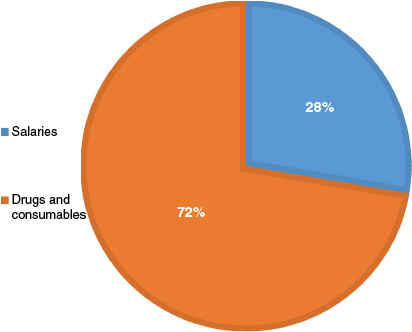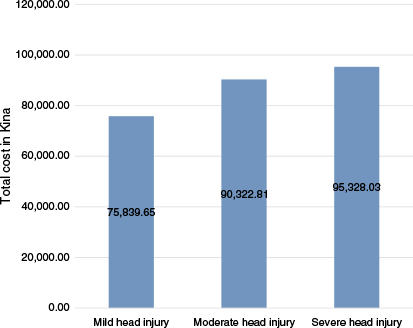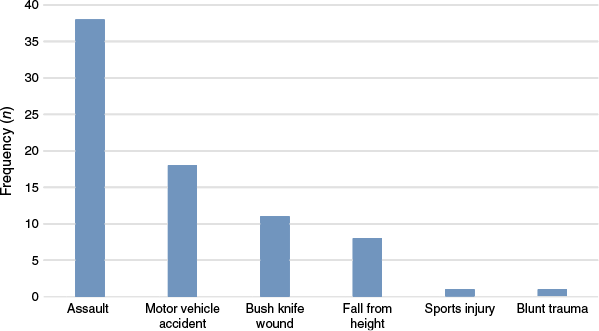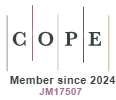The direct medical cost of managing traumatic brain injuries at Port Moresby General Hospital, Papua New Guinea: a prospective cost of illness study
Walter Paka A , Ian Umo B * , Esther Apuahe A and Benjamin Thomas AA
B
Abstract
Traumatic brain injury (TBI) is a major economic and public health problem globally. There is currently no literature on the direct medical cost of TBIs in Papua New Guinea that can guide policymakers on the burden of TBIs. As such, the aim of this study was to calculate the direct medical cost of managing TBI patients at the Port Moresby General Hospital (PMGH).
A prospective cost of illness study was carried out at the PMGH from 31 August 2023 to 1 January 2024. The study included 77 patients: 52 with mild head injuries, 16 with moderate head injuries, and 9 with severe head injuries. A bottom-up approach was employed to estimate direct medical costs from both the patient and hospital perspectives.
Over the 6-month period, the total direct medical cost amounted to K6,246,779.25 (US$1,561,694.81). On average, the direct medical cost per patient was K81,127.00 (US$20,281.75), with a standard deviation of ±341. Alcohol-related injuries accounted for 76.6% (n = 59) of total admissions. Hospital costs during the study period totalled K6,197,919.25 (US$1,549,479.81), representing 99.2% of the total direct medical costs associated with TBIs. Severe head injuries incurred the highest cost per TBI classification, averaging K95,328.03 (US$23,832.01) per patient, with a standard deviation of ±255.
TBIs are a common cause of admission to PMGH and are associated with significant direct medical costs. Public health interventions and government policies should focus on regulating alcohol production and consumption, as well as improving road traffic safety, to reduce the economic burden of TBIs.
Keywords: direct medical cost, health economics, neuro-surgery, Papua New Guinea, Port Moresby General Hospital, public health, trauma, traumatic brain injury.
Introduction
Traumatic brain injury (TBI) poses a significant economic and public health challenge.1 In 2019, an estimated 27.16 million new cases of TBI were diagnosed worldwide.2 The resulting economic burden on health systems has become substantial, with in-hospital costs reported to reach as high as US$401,808 per patient.3
The incidence of TBI in Papua New Guinea (PNG) is reported at 168 cases per 100,000 population, ranking among the highest in the Western Pacific region.4 At Port Moresby General Hospital (PMGH), TBIs constitute 36% of all neurosurgical admissions, often necessitating resources to provide for surgery, intensive care monitoring, and rehabilitation.5
Understanding the financial impact of TBIs on both the hospital and patient is crucial, especially given that, in 2022, the average direct medical cost of traumatic injuries in PNG was K45,900.40 (US$13,311.12)6. Currently, there is no existing literature on the direct medical costs of TBIs in PNG to guide policymakers in making informed decisions about financing and resource allocation. Therefore, the objective of this study was to calculate the direct medical cost of managing TBI patients at PMGH.
Methods
Study design
A prospective cost of illness study was conducted from 31 August 2023 to 1 January 2024.
Study setting
This study was conducted at PMGH, located in Port Moresby, the capital city of PNG. As of 2023, the estimated population of Port Moresby is approximately 409,831. PMGH is the country’s only tertiary hospital, serving a catchment population of about 1 million people, including residents of Central Province, Western Province, and Gulf Province.
The surgical department at PMGH has a total of 92 beds, including 12 high-dependency unit beds and 6 intensive care unit (ICU) beds. The neurosurgical unit does not have a dedicated ward and instead shares bed capacity with other specialties. The neurosurgical team consists of two neurosurgeons, two neurosurgical trainees, and rotating general surgery trainees.
Costing perspective and approach
In this study, we employed a bottom-up approach to direct medical costing7. This method focuses on calculating the expenses associated with providing care for a patient with a specific illness8. The costs were categorised into patient costs and hospital costs, both of which were analysed in this research. The methodology for direct medical costing was adapted from the work of Umo and James, which offers a comprehensive perspective on the overall financial burden on the healthcare system9,10.
The patient perspective on costing included hospital fees, which were obtained from PMGH and are detailed in Supplementary Appendix S1. These fees encompassed charges for admission, operations, full blood count tests, urea electrolyte and creatinine tests, liver function tests, and cross-matching procedures. Formula 2 in Table 1 was used to calculate the hospital fees per patient.
| Cost formulae | |
|---|---|
Assumptions: fixed supplier costs as per the medical dental catalogue and fixed staff salary as per adverstised positions.
Drugs and consumables costs were sourced from the National Department of Health Medical and Dental Catalogue.11 The costs of drugs and consumables were calculated using formula 1 in Table 1 and are financed by government funds.
Workforce costs were also included in the study. These were calculated based on the average number of healthcare workers attending to patients with TBI. Each healthcare worker’s fortnightly salary was determined using salary data obtained from PMGH position records. Formula 3 in Table 1 was applied to calculate the fortnightly salaries.
All costs were calculated in Kina (K), with conversions to US dollars based on the 2024 average exchange rate provided by the Bank of PNG: 1 Kina = 0.25 USD. Formula 3 in Table 1 was employed to calculate the total direct medical cost per patient.
A one-way sensitivity analysis was conducted on the cost per item assuming that it affects total direct medical costs. Thus ±20% variation to the cost of human resource was calculated to assess its impact on the mean cost per patient for each category in US dollars.
Study participants
The inclusion criteria for this study consisted of consecutive patients with TBI admitted to the surgical ward from either the emergency department or the children’s outpatient department at PMGH. Patients were excluded if they had polytrauma or were managed and discharged directly from the emergency department or children’s outpatient clinic. TBI was classified into mild, moderate, and severe head injury according to the Glasgow Coma Scale (GCS) as shown in Table 2.
| Patient characteristics | Number (%) | |
|---|---|---|
| Gender | ||
| Male | 65 (84.2) | |
| Female | 12 (15.6) | |
| Origin | ||
| Central | 28 (36.4) | |
| Gulf | 6 (7.8) | |
| Eastern Highlands | 6 (7.8) | |
| Chimbu | 5 (6.5) | |
| Morobe | 4 (5.2) | |
| Jiwaka | 4 (5.2) | |
| Hela | 5 (6.5) | |
| Enga | 5 (6.5) | |
| Southern Highlands | 4 (5.2) | |
| Western Highlands | 3 (3.9) | |
| Unknown | 3 (3.9) | |
| Autonomous Region of Bougainville | 1 (1.3) | |
| West Sepik | 1 (1.3) | |
| Manus | 1 (1.3) | |
| East Sepik | 1 (1.3) | |
| Age | ||
| 0–10 years | 14 (18.2) | |
| 11–17 years | 10 (13.0) | |
| 18–24 years | 17 (22.1) | |
| 25–31 years | 16 (20.8) | |
| 32–38 years | 13 (16.9) | |
| 39–41 years | 1 (1.3) | |
| 46–52 years | 1 (1.3) | |
| >52 years | 5 (6.5) | |
| Alcohol consumption | ||
| Yes | 59 (76.6) | |
| No | 18 (23.4) | |
| TBI (GCS score) | ||
| Mild head injury (13–15) | 52 (67.5) | |
| Moderate head injury (9–12) | 16 (20.8) | |
| Severe head injury (3–8) | 9 (11.7) | |
| Operations n = 32 | ||
| Burr hole and craniotomy | 13 (40.6) | |
| Examination under anaesthesia and suturing | 15 (19.5) | |
| Decompressive craniectomy | 4 (5.2) | |
| ICU admission | ||
| Yes | 9 (11.9) | |
| No | 68 (88.3) | |
Variables and data collection
Data on patient characteristics and costs were collected using a standardised survey form (Supplementary Appendix S2). Patient characteristics included age, gender, place of origin, cause of trauma, alcohol consumption, mechanism of injury, surgical procedures performed, length of hospital stay, and mortality. Data entry was done by the nursing officers and the author WP, spanning the period from patient admission to discharge. Data were entered into Microsoft Excel for analysis and presented as tables, graphs, percentages, and mean values.
Results
There were 77 patients admitted with TBI in this study. The male to female ratio was 5:1. The mean age of patients was 23.4 years; the minimum age was 5 years, and the maximum age was 70 years. Of the total patients, 36.4% (n = 28) were from Central Province as shown in Table 2. Alcohol-related injuries accounted for 76.6% (n = 59) of total admissions. Assaults accounted for 49% (n = 38) of admissions as shown in Fig. 1. There were no deaths during this study period, and the mean length of hospital stay was 10.5 days (s.d. ±3).
Patient costs
The total patient cost was K48,860 (US$12,215.00). Operation fees were the highest of patient costs as shown in Table 3.
| Fee | Cost in Kina (US$) | |
|---|---|---|
| Operation fee | 1500 (375) | |
| Ventilation | 675 (168.75) | |
| UEC fee | 50 (12.5) | |
| K wire implant fee | 50 (12.5) | |
| LFT fee | 40 (10) | |
| Admission fee | 5 (1.25) | |
| FBE fee | 5 (1.25) | |
| Cross-match fee | 5 (1.25) |
Abbreviations: UEC, urea electrolytes and creatinine; LFT, liver function test; FBE, full blood examination.
Hospital costs
The total hospital cost amounted to K6,197,919.25 (US$1,549,479.81), accounting for 99.2% of the overall direct medical costs. As illustrated in Fig. 2, drugs and consumables made up 72.0% of the hospital costs, with salaries and wages accounting for the remaining 28%.
Percentage per hospital cost on patients admitted for TBI at PMGH from 31 August 2023 to 1 January 2024.

The total direct medical cost over the 6-month period was K6,246,779.25 (US$1,561,694.81) and, on average, the direct medical cost was K81,127.00 (US$20,281.75) per patient (s.d. ±341). The highest cost per TBI classification was that of severe head injury with costs incurring K95,328.03 (US$23,832.01) per patient (s.d. ±255) as shown in Fig. 3.
Mean cost per patient per head injury severity in patients admitted to PMGH from 31 August 2023 to 1 January 2024.

Table 4 shows the cost per aetiology. Motor vehicle accidents (MVAs) had the highest direct medical cost per patient per aetiology (in comparison to number of patients) with K60,029.00 per patient (US$15,007.25). Total ICU associated costs for drugs, consumables, and equipment was K638,221.50 (US$159,555.38) at an average per patient of K70,913.50 (US$17,728.38).
| Aetiology | Number n = 77 | Total direct medical cost in Kina | Mean cost per patient in Kina (US$) | |
|---|---|---|---|---|
| Assault | 38 | 2,209,337.87 | 58,140.47 (14,535.12) | |
| Motor vehicle accident | 18 | 1,080,535.14 | 60,029.00 (15,007.25) | |
| Bush knife wound | 11 | 629,563.79 | 57,233.07 (14,308.27) | |
| Fall from height | 8 | 439,498.65 | 54,937.33 (13,734.33) | |
| Sports injury | 1 | 70,870.83 | 70,870.83 (17,717.70) | |
| Blunt trauma | 1 | 54,124.04 | 54,124.04 (13,531.01) |
The sensitivity analysis demonstrates that total direct medical costs are highly sensitive to changes in human resource costs, with a 20% increase leading to higher costs and a 20% decrease resulting in savings across all aetiologies (shown in Table 5).
| Aetiology | Original total cost (Kina) | Total cost with 20% increase (Kina) | Total cost with 20% decrease (Kina) | |
|---|---|---|---|---|
| Assault | 2,209,337.87 | 2,651,205.43 | 1,767,470.29 | |
| Motor vehicle accident | 1,080,522.00 | 1,296,626.40 | 864,417.60 | |
| Bush knife wound | 629,563.77 | 755,476.52 | 503,651.02 | |
| Fall from height | 439,498.65 | 527,398.37 | 351,598.91 | |
| Sports injury | 70,870.83 | 85,044.99 | 56,696.66 | |
| Blunt trauma | 54,124.04 | 64,948.85 | 43,299.23 |
Discussion
This study examines the direct medical costs of managing TBI patients at a tertiary hospital in PNG. The age distribution of TBI cases observed aligns with previous studies, which reported a higher incidence among individuals aged 18–40 years in PNG.12–14 Additionally, our findings show a predominance of male cases, consistent with the 2019 global age-standardised incidence rate of 346 per 100,000 population.2
Assaults and MVAs were identified as the leading causes of TBI in this study. Similarly, a previous study by Liko et al. found that assaults and MVAs accounted for 32 and 49% of all TBI cases, respectively, at PMGH.13 On a global scale, Huang et al. reported that falls contribute to over 30% of TBI cases worldwide, whereas MVAs were more prevalent as a cause of TBIs in African countries.2
MVAs incurred the highest direct medical cost per patient among all TBI aetiologies in this study. In 2018, 8.9% of all admissions to PMGH were MVA-related, with 46% of the patients being pedestrians.15 Our study revealed that the average cost of drugs, consumables, and equipment for managing TBI cases resulting from MVAs was K60,029.00 (US$15,007.25) per patient. This aligns with findings of Rubin, who reported in-hospital TBI costs ranging from US$12,100.00 to US$21,000.00.16
In PNG, severe head injuries account for 30–59% of all TBI admissions.8–11 Globally, they represent 52.8% of all TBI cases.2 In this study, we found that managing a single patient with a severe head injury cost K95,328.03 (US$23,832.01). These high costs are primarily due to the significant morbidity associated with severe head injuries, which drives up direct healthcare expenses.16 This was particularly evident among patients admitted to the ICU, where K638,221.50 (US$159,555.38) was spent on drugs and consumables over the 5-month duration of the study.
Weil et al. identified alcohol intoxication as one of the strongest predictors of sustaining a TBI.17 In this study, 76.6% (n = 59) of patients were under the influence of alcohol at the time of injury. Alcohol abuse remains a significant public health concern in PNG, with the World Health Organization highlighting that the country has surpassed critical levels of alcohol-related issues. This is compounded by outdated laws governing the regulation, manufacturing, sale, and consumption of alcohol.18,19
In PNG, the public health system is primarily funded by the government through the National Department of Health and the Department of Personal Management. This study found that the hospital bore 99.2% of all direct medical costs. In many low- to middle-income countries, out-of-pocket payments account for over 50% of total health expenditure.20 Although the PNG government covers the majority of healthcare costs, 29% of individuals in rural areas seeking surgical care are pushed into poverty due to expenses related to transport, food, and accommodation.21
Our sensitivity analysis showed that total direct medical costs are highly sensitive to changes in human resource costs (Table 5). The most significant impact is observed in conditions with higher patient volumes, such as assault and motor vehicle accidents, where total costs increase or decrease notably. In contrast, conditions with fewer patients, like sports injury and blunt trauma, show less dramatic changes.
The outcomes of TBI patients largely depend on the severity of the injury. A study by Kaptigau reported a case fatality rate of just under 30% among patients with moderate to severe head injuries managed at PMGH.22 However, in the present study, no deaths were recorded. This may have been as a result of our exclusion criteria in which head injury patients were excluded if they had polytrauma or had died while being managed at the emergency department. To mitigate costs, preventive measures have focused on addressing MVAs and alcohol consumption. Additionally, preventing secondary brain injury is crucial and can be achieved by maintaining cerebral oxygenation and blood pressure through proper airway management, ventilation support, fluid administration, and the use of inotropes.23 This is particularly important, as a study by Umo et al. found that TBI patients with hypoxia in PNG faced the highest risk of mortality.12
This study has several limitations. The direct medical costs reported do not account for expenses related to power, water, building infrastructure, or outpatient follow-up care. Additionally, the medical and dental catalogue used for cost estimation was last updated in 2012, and confirmation of blood alcohol levels was not possible, with data relying solely on patient history. Consequently, the costs presented are likely underestimated, as a comprehensive societal cost analysis could not be conducted. Despite these limitations, the study successfully achieved its objectives and provides valuable preliminary data on the direct medical costs of managing TBI at PMGH.
Conclusion
TBIs are a common cause of admission to PMGH and are associated with significant direct medical costs. Furthermore, variations in human resource costs can notably influence the total cost, especially for high-volume conditions. Public health interventions and government policies should focus on regulating alcohol production and consumption, as well as improving road traffic safety, to reduce the economic burden of TBIs.
Acknowledgements
The authors would like to thank Ms. Sharon Maliaba of the PMGH Hospitals Main Operating Theatre Pharmacy, Sr. Dimugu and the nursing team of ward 2c, Sr. Malinguta and the surgical ward nurses of ward 2a and Sr. Hilda Simeon and Sr. Nellie Kamblijambi of ward 7. We would like to thank Dr Newman Berry of the Anaesthesia Department for his support and cooperation throughout this study.
References
1 Dewan MC, Rattani A, Gupta S, Baticulon RE, Hung YC, Punchak M, Agrawal A. Estimating the global incidence of traumatic brain injury. J Neurosurg 2018; 130(4): 1080-1097.
| Crossref | Google Scholar | PubMed |
2 Huang XF, Ma SF, Jiang XH, Song RJ, Li M, Zhang J, Sun TJ, Hu Q, Wang WR, Yu AY, Li H. Causes and global, regional, and national burdens of traumatic brain injury from 1990 to 2019. Chin J Traumatol 2024; 27(6): 311-322.
| Crossref | Google Scholar | PubMed |
3 Van Dijck J, Dijkman MD, Ophuis RH, de Ruiter G, Peul WC, Polinder S. In-hospital costs after severe traumatic brain injury: A systematic review and quality assessment. PLoS One 2019; 14: e0216743.
| Crossref | Google Scholar | PubMed |
4 GBD 2016 Traumatic Brain Injury and Spinal Cord Injury Collaborators. Global, regional, and national burden of traumatic brain injury and spinal cord injury, 1990–2016: a systematic analysis for the Global Burden of Disease Study 2016. Lancet Neurol 2019; 18: 56-87.
| Crossref | Google Scholar | PubMed |
5 Kaptigau WM, Rosenfeld JV, Kevau I, Watters DA. The Establishment and Development of Neurosurgery Services in Papua New Guinea. World J Surg 2016; 40: 251-257.
| Crossref | Google Scholar | PubMed |
6 Umo I, James K, Didilemu F, Sinen B, Borchem I, Inaido D, Ikasa R. The direct medical cost of trauma etiologies and injuries in a resource limited setting of Papua New Guinea: A prospective cost of illness study. Lancet Reg Health West Pac 2022; 20: 100379.
| Crossref | Google Scholar | PubMed |
8 Fautrel B, Boonen A, de Wit M, et al. Cost assessment of health interventions and diseases. RMD Open 2020; 6: e001287.
| Crossref | Google Scholar | PubMed |
9 Umo I, James K. The direct medical cost of acute appendicitis surgery in a resource-limited setting of Papua New Guinea. World J Surg 2021; 45: 3558-3564.
| Crossref | Google Scholar | PubMed |
10 Shrime MG. Getting costs right in global surgery. World J Surg 2021; 45: 3565-3566.
| Crossref | Google Scholar | PubMed |
11 Papua New Guinea Medical and Dental Health Catalogue. National Department of Health, 10th edn. 2012. Available at https://drive.google.com/uc?export=download&id=1OIJFZvSQ8STYTrP1UBSUDQ2NREdYFvBK [cited 2024].
12 Umo I, Silihtau S, James K, Samof L, Ikasa R, Commons R. An epidemiological and clinical study of Traumatic Brain Injury in Papua New Guinea managed by General Surgeons in Two Provincial Hospital. Indian J Surg 2023; 85: 868-875.
| Crossref | Google Scholar |
13 Liko O, Chalau P, Rosenfeld JV, Watters DA. Head injuries in Papua New Guinea. PNG Med J 1996; 39: 100-104.
| Google Scholar | PubMed |
14 Kaptigau WM, Ke L, Rosenfeld JV. Open depressed and penetrating skull fractures in Port Moresby General Hospital from 2003 to 2005. PNG Med J 2007; 50: 58-63.
| Google Scholar | PubMed |
15 Asa H. Road Traffic Injuries at the Orthopedic unit, Port Moresby General Hospital. 2019. Available at https://devpolicy.org/2019-PNG-Update/Presentations/Parallel-2C-Road-traffic-injuries-at-the-orthopaedic-unit-Henao-Asa.pdf
16 Rubin R. Traumatic Brain Injury Hospital Stays Are Longer, More Costly. JAMA 2020; 323(20): 1998.
| Crossref | Google Scholar | PubMed |
17 Weil ZM, Corrigan JD, Karelina K. Alcohol Use Disorder and Traumatic Brain Injury. Alcohol Res 2018; 39(2): 171-180.
| Google Scholar | PubMed |
19 Pumuye GM, Kuman J. The Need for Law Reform in Papua New Guinea: Part 1. Canberra: Australian National University; 2020 [cited 2025 Jun 16]. Available from https://openresearch-repository.anu.edu.au/server/api/core/bitstreams/bb7ace1c-9bf4-4f36-bf84-bb6b9dd9d4cf/content
20 Asante A, Price J, Hayen A, Jan S, Wiseman V, Jan V. Equity in Health Care Financing in Low- and Middle-Income Countries: A Systematic Review of Evidence from Studies Using Benefit and Financing Incidence Analyses. PLoS One 2016; 11(4): e0152866.
| Crossref | Google Scholar | PubMed |
21 James K, Borchem I, Talo R, Aihi S, Baru H, Didilemu F, Moore EM, McLeod E, Watters DA. Universal access to safe, affordable, timely surgical and anaesthetic care in Papua New Guinea: the six global health indicators. ANZ J Surg 2020; 90: 1903-1909.
| Crossref | Google Scholar | PubMed |
22 Kaptigau WM. A practical approach to the management of head injuries in Papua New Guinea. P N G Med J 2007; 50(1–2): 77-86.
| Google Scholar | PubMed |
23 Vella MA, Crandall ML, Patel MB. Acute Management of Traumatic Brain Injury. Surgical Clinics of North America 2017; 97(5): 1015-1030.
| Crossref | Google Scholar |



